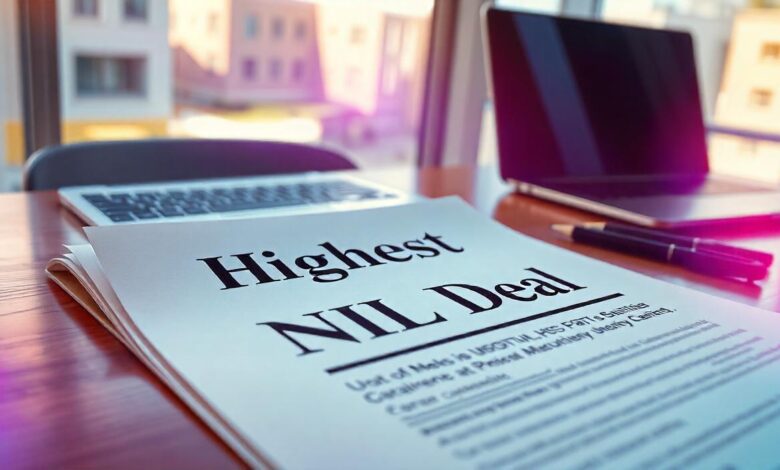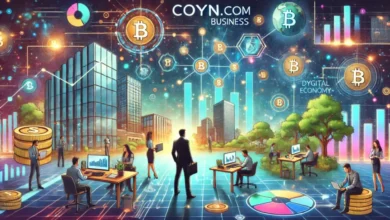Exploring the Highest NIL Deals in 2023: A New Era for Athlete Compensation

Introduction to NIL Deals
Highest NIL Deals the landscape of college athletics has undergone a transformative shift in recent years, particularly with the advent of Name, Image, and Likeness (NIL) deals. These arrangements empower student-athletes to monetize their personal brand, marking a significant departure from previous regulations that prohibited such compensation. The NCAA, in a landmark decision, changed its policies in July 2021, allowing student-athletes to engage in NIL activities without jeopardizing their eligibility. This development has opened new avenues for financial opportunities that were previously unavailable to them.
NIL deals encompass a range of agreements, including sponsorships, social media promotions, and merchandise sales, which students can leverage to enhance their economic standing. This shift represents not only a personal advantage for the athletes but also has broader implications for college sports as a whole, as programs now compete for top talent not just based on athletic prowess but also on branding potential. The integration of these strategies into athletic programs highlights the need for students to understand contract negotiations, marketing, and even financial management.
The emergence of the highest NIL deals has started to attract national attention, showcasing just how lucrative this new system can be for select individuals. Several athletes have signed endorsements worth millions, a stark contrast to the traditional model where compensation was limited to scholarships and stipends. As the NIL market continues to evolve, it raises questions about equity, transparency, and the long-term impact on the collegiate sports landscape. The new dynamics necessitate a nuanced understanding of how these deals operate and their role in reshaping the athlete experience.
The Impact of NIL Legislation
The advent of Name, Image, and Likeness (NIL) legislation has transformed the landscape of college sports, fundamentally altering how athletes can leverage their personal brands for financial gain. Before this legislative shift, collegiate athletes were prohibited from profiting from their talents in any capacity, leading to concerns about fairness and equity. The recent changes have been motivated by a growing recognition of the rights of student-athletes, advocating that they deserve the same opportunities to capitalize on their identities as their professional counterparts.
As institutions scramble to adapt to these changes, there are significant challenges on multiple fronts. Universities must navigate the complexities of compliance, ensuring that they align with state and federal regulations while simultaneously offering support systems for athletes to maximize their opportunities. This includes guidance on contract negotiations, financial literacy, and potential pitfalls of endorsements. Furthermore, there is a pressing need for institutions to consider the implications of NIL deals on team dynamics and the collegiate experience. As some athletes secure lucrative endorsements, concerns regarding equity among teammates and the traditional amateur ethos come to the forefront.
Despite these challenges, the potential benefits of NIL legislation are substantial. Athletes can now enhance their financial stability, which can be particularly critical for those looking to offset educational costs or support their families. Moreover, schools and sponsors stand to gain from cultivating successful partnerships with top athletes, as witnessed in the landscape of the highest NIL deals that have emerged since the legislation’s implementation. However, the evolving nature of these agreements also poses risks, including the potential for exploitation and an increasingly commercialized college sports environment. As the landscape continues to evolve, it will be essential to monitor how these dynamics influence the future of college athletics.
Top Athletes Cashing In: Who Made the List?
As the landscape of college sports continues to evolve, the highest NIL deals in 2023 have become a focal point for both athletes and fans. The rise of name, image, and likeness opportunities has enabled student-athletes to monetize their personal brands, and several individuals have distinguished themselves through remarkable agreements. This section examines some of the most notable athletes who have successfully capitalized on this new era of athlete compensation.
Among the standouts, Arch Manning, the highly touted quarterback from the University of Texas, has garnered significant attention. With a family legacy in football and a stellar high school career, Manning has attracted substantial endorsements from brands such as Nike and Blockchain.com. His presence not only bolsters the Longhorns’ reputation but also positions him as a lucrative figure in the NIL landscape.
Another prominent athlete is Bronny James, the eldest son of NBA legend LeBron James, currently playing for USC. His name recognition and talent on the court have translated into impressive partnerships with companies like Nike and PS5. As he navigates his collegiate career, Bronny is maximizing his earning potential through endorsements, reflecting a trend where personal branding has become as critical as on-field success.
In addition, female athletes are also making headlines within this changing compensation framework. Caitlin Clark, the Iowa basketball star, secured her place among the highest nil deals with major endorsements from prestigious brands, including Adidas and Gatorade. Clark’s stellar performance in the NCAA tournament significantly amplified her appeal, showcasing how exemplary skillset and marketability are integral to securing high-value NIL agreements.
These athletes represent just a fraction of a growing cohort of young talents embracing the new opportunities provided by NIL. Through strategic partnerships, their achievements and marketability are driving the demand for endorsements, marking a significant shift in how amateur athletes can benefit financially from their hard work and personal brands.
Record-Breaking Deals: The Numbers Behind the Success
In 2023, the landscape of athlete compensation has seen transformative changes, marked by record-breaking NIL deals that have redefined the financial dynamics of college athletics. According to recent reports, the total value of NIL deals for college athletes surpassed $1 billion, with multiple contracts exceeding the prestigious million-dollar mark. Prominent figures such as Arch Manning, a quarterback from Texas, secured a staggering NIL deal worth $8 million, illustrating the demand for premier athletes in the realm of endorsements.
Historically, athlete compensation was largely limited to scholarships and stipends, with collegiate athletes prohibited from profiting off their own name, image, and likeness. However, the introduction of NIL regulations has opened the floodgates for negotiations, consequently raising the standard for what the highest nil deals can entail. For instance, basketball players like Bronny James are reported to have signed agreements valued at over $7 million, signifying a seismic shift from the traditional compensation framework.
Industry experts suggest that the growth of these lucrative endorsements is not merely a passing trend but rather a significant indication of evolving market dynamics. The increasing connection between athletes and brands is influenced by social media platforms, which allow athletes to engage directly with their fanbase, thus enhancing their marketability. Analysts posit that brands are now more willing to invest substantially in athlete endorsements, recognizing their potential to drive consumer engagement and sales. Furthermore, with the collective bargaining power of college athletes growing, there is an optimistic outlook regarding future NIL deals, as it paves the way for even greater financial opportunities across various sports disciplines.
The implications of these record-breaking contracts extend beyond immediate financial gain, reflecting a fundamental shift in how athletes are perceived within the market. As the demand for endorsements continues to rise, it confirms that the era of significant NIL deals is just beginning.
Negotiation Strategies for Athletes
In the evolving landscape of athlete compensation, the presence of the highest NIL deals presents both opportunities and challenges. Athletes must approach negotiations with a keen understanding of their brand value. The first step in this process is self-assessment, where athletes evaluate their marketability, social media presence, and overall influence within their sport and beyond. This self-awareness equips athletes with the confidence needed to approach potential sponsors effectively.
Building connections is crucial in securing valuable NIL agreements. Athletes can leverage their existing networks, such as agents, coaches, and alumni, to identify potential sponsorship opportunities. Networking events, conferences, and social media platforms can serve as effective venues for reaching out to brands that align with their values. Personalizing outreach efforts by demonstrating a genuine interest in the brand and showcasing their unique story can significantly enhance an athlete’s chances of establishing meaningful partnerships.
When it comes to negotiating the terms of NIL deals, it is essential for athletes to be informed and prepared. They should seek to understand the financial implications of the agreement, ensuring that they receive fair compensation relative to their brand recognition and market potential. Utilizing the services of legal professionals experienced in NIL contracts can provide athletes with valuable insights and protections. Athletes should negotiate for terms that allow for long-term growth and sustainability, rather than short-term gains alone. Offering flexible terms that can evolve with their careers indicates a forward-thinking approach that many brands appreciate.
In conclusion, mastering negotiation strategies is vital for athletes aiming for the highest NIL deals. By valuing their brand appropriately, fostering connections, and ensuring equitable terms, they can achieve agreements that not only enhance their immediate prospects but also support their long-term career goals.
Challenges and Controversies in the NIL Space
The introduction of Name, Image, and Likeness (NIL) deals has undeniably transformed the landscape of collegiate athletics, but it has also brought forward a multitude of challenges and controversies that demand careful examination. One of the primary concerns revolves around the equity among athletes across different sports. While high-profile athletes in sports such as football and basketball may reap substantial benefits from the highest NIL deals, those in less popular or financially lucrative sports often find themselves at a disadvantage. This disparity raises questions about fairness and the true spirit of competition.
Moreover, potential conflicts of interest have emerged as stakeholders in collegiate athletics navigate the new NIL landscape. Coaches, athletic programs, and even sponsors may face dilemmas that could compromise the integrity of the sport. The intertwining relationships between these entities could lead to scenarios where decisions on recruitment and development are influenced more by financial prospects than by athletes’ academic or athletic merits. Such developments may further exacerbate the imbalance among varying sports and institutions.
Another significant area of contention is the ongoing debate regarding the concept of amateurism in sports. Historically, athletes have been labeled as amateurs, which restricted their financial endorsements. The shift towards recognizing NIL rights has ignited discussions about the fundamental principles of amateurism and its relevance in a modern context. Some argue that allowing athletes to monetize their worth undermines traditional values of college sports, while others claim that it is a necessary evolution that acknowledges the hard work and talent of young athletes.
Furthermore, regulatory concerns have come to the forefront, as governing bodies strive to establish frameworks to manage NIL activities. The absence of standardized regulations across institutions has led to confusion and inconsistency, prompting many colleges to adopt varied approaches. As these complexities continue to unfold, institutional responses to such challenges will play a crucial role in shaping the future of NIL deals and athlete compensation in collegiate sports.
The Role of Social Media in NIL Success
In the rapidly evolving landscape of athlete compensation, social media plays a pivotal role in maximizing the potential of the highest NIL deals available. Platforms such as Instagram, Twitter, TikTok, and YouTube have allowed athletes to cultivate their personal brands, significantly extending their reach and influence. By leveraging these platforms, athletes can engage directly with fans, showcase their personalities, and enhance their visibility in an increasingly competitive market.
Engagement through social media is not merely about having a large following; it is about actively interacting with audiences. High-profile athletes like Bryce Young and Olivia Dunne have adeptly utilized their social media channels not just to share their athletic accomplishments, but to develop a relatable persona that resonates with fans. This connection can be a decisive factor for brands considering partnerships, as companies seek ambassadors who can genuinely connect with their target demographics.
Moreover, athletes can use social media to highlight sponsorships and endorsements, turning posts into marketing tools that can attract more lucrative contracts. By creating compelling content that showcases partnerships, they can demonstrate their marketing value, ultimately leading to the highest NIL deals in the industry. Buoyed by their online presence, many athletes have successfully transitioned from student-athletes to influential marketable figures.
Case studies have shown that elite athletes who marry brand concepts with their social media content see increased profitability in their NIL ventures. For instance, Texas Longhorns quarterback Arch Manning has harnessed his presence on various platforms to cultivate a strong image, drawing the attention of major brands and endorsements. His strategic approach exemplifies how social media can be a powerful tool for athletes aiming to enhance their NIL portfolios.
As the connection between social media engagement and NIL success becomes more evident, it is crucial for athletes to understand how to effectively navigate these channels to represent themselves, their brands, and their potential for attracting the highest nil deals available. This strategy not only enhances their marketability but also shapes their future opportunities in sporting and commercial landscapes.
Future Trends in NIL Deals
As the landscape of athlete compensation continues to evolve, several notable trends are anticipated in the realm of Name, Image, and Likeness (NIL) deals over the coming years. The emergence of the highest NIL deals signifies a shift not only in how athletes are compensated but also in the ways brands and agencies engage with these individuals.
One significant trend is the likely growth of exclusive NIL agreements. Brands are becoming increasingly interested in building long-term relationships with athletes rather than engaging in one-off sponsorships. This could lead to more athletes being nurtured as brand ambassadors, showcasing their commitment to a specific brand and enhancing its visibility. Exclusive partnerships will likely yield substantial returns for both the athletes and the brands, fostering deeper connections that resonate with audiences.
Furthermore, the role of technology and digital platforms is expected to expand significantly. Social media has already revolutionized athlete marketing, allowing them to interact with fans directly and create personal brands. Innovations in digital content creation, such as augmented and virtual reality, present new avenues for engagement that could redefine the highest NIL deals. These technologies could enable athletes to offer immersive experiences, thereby increasing their marketability and potential earnings.
Athlete representation is also shifting, with agencies becoming increasingly influential in navigating the complexities of NIL agreements. As the market matures, specialized agencies may emerge, focusing solely on managing NIL deals for athletes. This shift could lead to greater negotiation power for athletes, ensuring they receive fair compensation while maximizing their brand potential. The combination of agency expertise and strategic partnerships will likely play a pivotal role in shaping the future of NIL deals.
These emerging trends suggest a dynamic and adaptive environment for athlete compensation, as the market continues to grow and evolve.
Conclusion: The Evolution of Athlete Compensation
The landscape of athlete compensation has undergone substantial transformation in recent years, largely driven by the advent of Name, Image, and Likeness (NIL) deals. These agreements have not only provided athletes with unprecedented financial opportunities but have also redefined the culture surrounding sports sponsorships. The highest NIL deals reflect a broader trend towards recognizing athletes as brand ambassadors who can monetize their personal brands outside traditional avenues. This growth is indicative of an evolving sports environment where athletes are no longer viewed solely as participants in their respective games but as influential personalities capable of generating substantial revenue.
The implications of these changes resonate deeply within the realm of college athletics and professional sports alike. Athletes now have the chance to align themselves with brands that share their values and interests, ensuring a more authentic partnership. These relationships not only benefit the athletes financially but also offer brands access to unique marketing platforms. As the highest NIL deals continue to emerge, we can anticipate a growing number of athletes engaging with corporations to create innovative sponsorship strategies that resonate with their audiences.
Moreover, the ongoing evolution of athlete compensation highlights the importance of athlete rights and their ability to exert control over their careers and financial destinies. Athletes are increasingly empowered to make choices that reflect their individual aspirations and talents. This shift promises a future where athletes can negotiate more favorable terms in their partnerships, contributing to their financial well-being beyond their performance on the field.
In conclusion, the evolution of NIL deals marks a significant milestone in sports history. As the dynamics of athlete compensation continue to evolve, it is essential for stakeholders—athletes, brands, and fans—to adapt to this new reality, recognizing the implications of these arrangements that celebrate both athletic talent and entrepreneurial spirit.
You may also read this Skyrix



